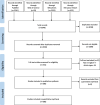Retracted articles in rehabilitation: just the tip of the iceberg? A bibliometric analysis
- PMID: 33292803
- PMCID: PMC7706289
- DOI: 10.1186/s40945-020-00092-w
Retracted articles in rehabilitation: just the tip of the iceberg? A bibliometric analysis
Abstract
Background and aim: The volume of withdrawn publications in scholarly disciplines has grown steadily, but there is little awareness about this issue in rehabilitation. The aim of this study was to analyze the extent of retracted articles pertaining to rehabilitation.
Methods: Retracted articles were searched in 4 different bibliographic databases from their inception to April 2020: PubMed, Web of Science, WikiLetters and Retraction Watch. Three independent reviewers assessed the relevance of the retrieved articles to the rehabilitation area.
Results: Of 280 rehabilitation-related publications retracted between 1984 and 2020, 83 (29.6%) were published in 55 full open access journals and 197 (70.4%) were published in 147 traditional, non-open access or hybrid journals. In the last 10 years (2009-2018) there was a significant steady increase in both the total number of retractions (p < 0.005; r = 0.856; R2 = 0.733) and retraction rate per year (p < 0.05; r = 0.751; R2 = 0.564). However, the number of retractions represents a very small percentage (~ 0.1%) of the overall volume of publications in rehabilitation.
Conclusions: Our data indicate that the number of retracted articles in rehabilitation is increasing, although the phenomenon is still limited. However, the true prevalence of misconduct may go unnoticed due to the large number of low-quality journals not indexed in the searched databases. Physiotherapists should be aware of the danger of misleading information originating from withdrawn publications.
Keywords: Physiotherapy; Rehabilitation; Research misconduct; Retracted publication.
Conflict of interest statement
The authors declare they have no competing interests.
Figures




Similar articles
-
Research misconduct in health and life sciences research: A systematic review of retracted literature from Brazilian institutions.PLoS One. 2019 Apr 15;14(4):e0214272. doi: 10.1371/journal.pone.0214272. eCollection 2019. PLoS One. 2019. PMID: 30986211 Free PMC article.
-
Retractions in Rehabilitation and Sport Sciences Journals: A Systematic Review.Arch Phys Med Rehabil. 2020 Nov;101(11):1980-1990. doi: 10.1016/j.apmr.2020.03.010. Epub 2020 May 10. Arch Phys Med Rehabil. 2020. PMID: 32402503
-
A comprehensive survey of retracted articles from the scholarly literature.PLoS One. 2012;7(10):e44118. doi: 10.1371/journal.pone.0044118. Epub 2012 Oct 24. PLoS One. 2012. PMID: 23115617 Free PMC article.
-
Comprehensive analysis of retracted journal articles in the field of veterinary medicine and animal health.BMC Vet Res. 2022 Feb 18;18(1):73. doi: 10.1186/s12917-022-03167-x. BMC Vet Res. 2022. PMID: 35180878 Free PMC article.
-
A survey of retracted articles in dentistry.BMC Res Notes. 2017 Jul 6;10(1):253. doi: 10.1186/s13104-017-2576-y. BMC Res Notes. 2017. PMID: 28683764 Free PMC article.
Cited by
-
Retracted articles in scientific literature: A bibliometric analysis from 2003 to 2022 using the Web of Science.Heliyon. 2024 Sep 26;10(20):e38620. doi: 10.1016/j.heliyon.2024.e38620. eCollection 2024 Oct 30. Heliyon. 2024. PMID: 39640756 Free PMC article.
-
Cairo Consensus Statement on Research Integrity of Randomised Clinical Trials.Pak J Med Sci. 2024 Sep;40(8):1596-1600. doi: 10.12669/pjms.40.8.9779. Pak J Med Sci. 2024. PMID: 39281217 Free PMC article. No abstract available.
-
Characteristics of global retractions of schizophrenia-related publications: A bibliometric analysis.Front Psychiatry. 2022 Aug 1;13:937330. doi: 10.3389/fpsyt.2022.937330. eCollection 2022. Front Psychiatry. 2022. PMID: 35978846 Free PMC article.
-
What can we learn from retracted studies in the nursing field in the last 20 years? Findings from a scoping review.Acta Biomed. 2022 May 12;93(S2):e2022193. doi: 10.23750/abm.v93iS2.12954. Acta Biomed. 2022. PMID: 35545979 Free PMC article.
References
-
- COPE Council . COPE guidelines: retraction guidelines. Version 2. 2019.
-
- Steen RG. Retractions in the medical literature: who is responsible for scientific integrity? AMWA J. 2011;26(1):2–7.
-
- Sheth BP, Thaker VS. Scientific retraction: a synonym for pseudoscience? Acta Bioeth. 2014;20(1):93–97. doi: 10.4067/S1726-569X2014000100010. - DOI
-
- Armstrong D, Winstein KJ. Top pain scientist fabricated data in studies, hospital says. Wall St J. 2009;A:12.
Publication types
LinkOut - more resources
Full Text Sources
Miscellaneous
